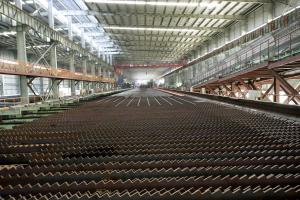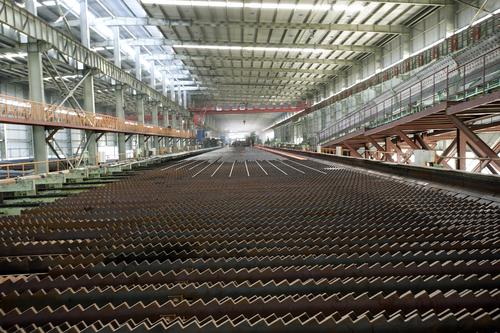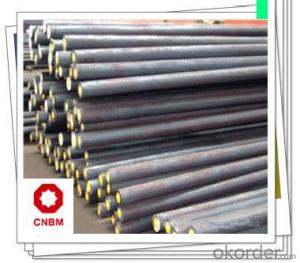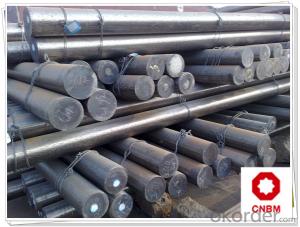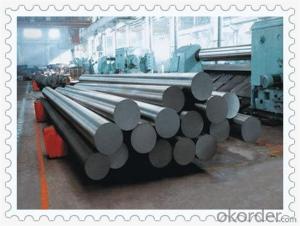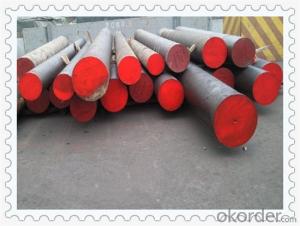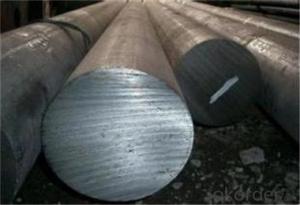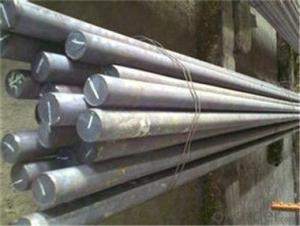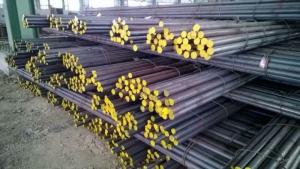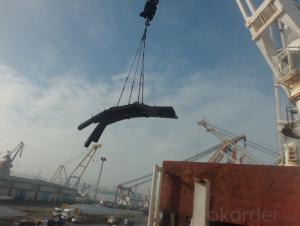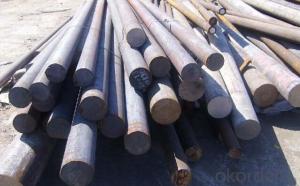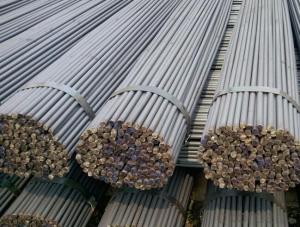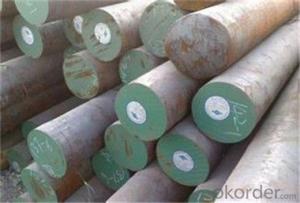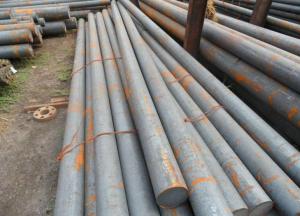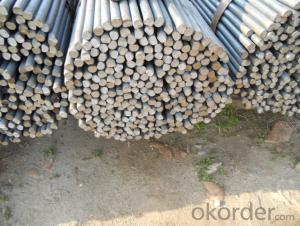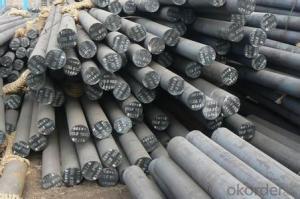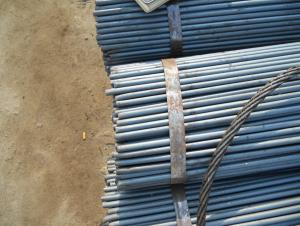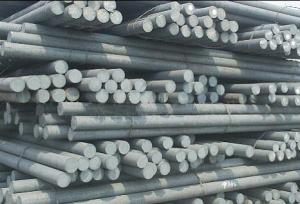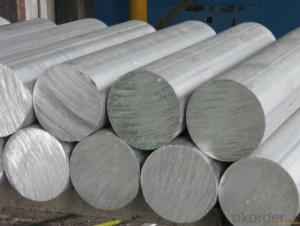Hot Rolled Steel Carbon Round Bar
- Loading Port:
- China Main Port
- Payment Terms:
- TT or LC
- Min Order Qty:
- -
- Supply Capability:
- -
OKorder Service Pledge
OKorder Financial Service
You Might Also Like
Product Description:
OKorder is offering Round Bar at great prices with worldwide shipping. Our supplier is a world-class manufacturer of steel, with our products utilized the world over. OKorder annually supplies products to European, North American and Asian markets. We provide quotations within 24 hours of receiving an inquiry and guarantee competitive prices.
Product Applications:
1. Hot rolled round bar of 6-25mm, or small round is mostly used for straight bundles supply, and used for steel, bolts and various mechanical parts. While the bigger round bar, or more than 25mm hot rolled bar, is mainly for the manufacture of mechanical parts or for seamless steel billet.
2. Besides, we can supply some especial material steel round bar that can be used for main shaft of steamer, hummer shank, with big section and supper force.
Product Advantages:
OKorder's Round Bar are durable, strong, and resist corrosion.
Main Product Features:
· Premium quality
· Prompt delivery & seaworthy packing (30 days after receiving deposit)
· Corrosion resistance
· Can be recycled and reused
· Mill test certification
· Professional Service
· Competitive pricing
Product Specifications:
1. Grade: Q195, Q235, Q345
2. Diameter: 6mm-150mm
3. Length: 6m, 9m, 12m or as customer’s request
4. Tolerance: Within ±5% for weight; ±2mm for diameter
5. Note: The price can be better is the quantity is good
6. Chemical composition
Alloy No | Element (%) | ||||
C | Mn | S | P | Si | |
Q195 | 0.06-0.12 | 0.25 | ≤0.05 | ≤0.045 | ≤0.3 |
Q235 | 0.12—0.20 | 0.3—0.7 | ≤0.045 | ≤0.045 | ≤0.3 |
Q345 | ≤0.2 | 1.00-1.60 | ≤0.045 | ≤0.045 | ≤0.55 |
Packaging & Delivery of Round Bar
Packaging Detail: All goods are packed in bundle with steel strips and shipped by break bulk vessel or container (depend on target market and different ports)
Delivery Detail: 45 days
Trade terms: FOB, CFR, CIF
MOQ: 25 tons per specification; we can negotiate the quantity if the specification is normal or we have stock of one specification.
Weight: Theprice invoicing on theoretical weight basis or actual weight basis depends on customer’s request.
Shipment: The shipment of bulk break or container is depends on customer’s request and the situation of the port of destination.
Documents given: Full set of original clean on board bill of lading; Original signed commercial invoice; Original packing list; Policy of insurance; Certificate of origin and what the target market needs.
FAQ:
Q1: Why buy Materials & Equipment from OKorder.com?
A1: All products offered byOKorder.com are carefully selected from China's most reliable manufacturing enterprises. Through its ISO certifications, OKorder.com adheres to the highest standards and a commitment to supply chain safety and customer satisfaction.
Q2: How do we guarantee the quality of our products?
A2: We have established an advanced quality management system which conducts strict quality tests at every step, from raw materials to the final product. At the same time, we provide extensive follow-up service assurances as required.
Q3: How soon can we receive the product after purchase?
A3: Within three days of placing an order, we will begin production. The specific shipping date is dependent upon international and government factors, but is typically 7 to 10 workdays.
Q4: What makes stainless steel stainless?
A4: Stainless steel must contain at least 10.5 % chromium. It is this element that reacts with the oxygen in the air to form a complex chrome-oxide surface layer that is invisible but strong enough to prevent further oxygen from "staining" (rusting) the surface. Higher levels of chromium and the addition of other alloying elements such as nickel and molybdenum enhance this surface layer and improve the corrosion resistance of the stainless material.
Images:
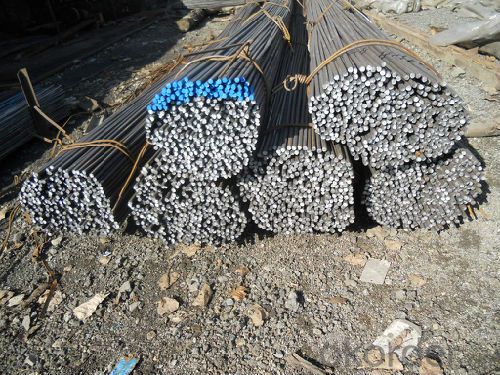
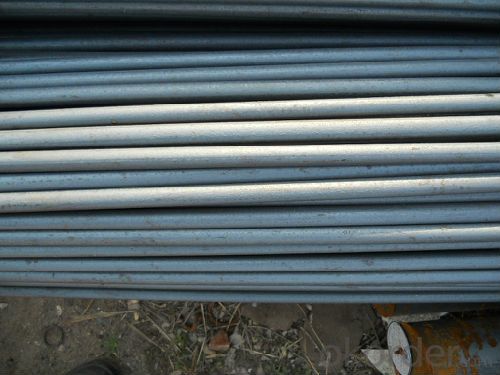
- Q: How many grades of steel are round steel?
- Secondly, the round steel only shows the shape of steel, all kinds of steel have round steel, it can not explain the nature and composition of steel.
- Q: What are the advantages of using wear-resistant steel round bars?
- Wear-resistant steel round bars offer numerous benefits: 1. Enhanced durability: These round bars are specifically designed to withstand high levels of abrasion and wear. They have a high hardness level, which makes them resistant to surface damage caused by friction, impact, or scraping. As a result, their lifespan is extended, reducing the need for frequent replacements. 2. Increased strength: Wear-resistant steel round bars possess exceptional strength properties, allowing them to withstand heavy loads and extreme conditions. This makes them suitable for various applications in industries like mining, construction, manufacturing, and transportation, where strength and resilience are crucial. 3. Improved safety: By using wear-resistant steel round bars, a safer working environment is ensured. Their high resistance to wear minimizes the risk of accidents and injuries caused by equipment failures or structural damage. This is particularly important in industries involving heavy machinery, tools, or structures. 4. Cost-effectiveness: Although wear-resistant steel round bars may have a higher initial cost compared to regular steel bars, their extended lifespan and reduced maintenance requirements make them a cost-effective choice in the long run. The reduced need for replacements and repairs leads to lower downtime, increased productivity, and ultimately, decreased operational costs. 5. Versatility: Wear-resistant steel round bars can be used in a variety of applications due to their versatility. They can be easily machined, welded, or formed into different shapes and sizes to meet specific requirements. This flexibility allows for their use in various industries and applications, making them an ideal choice for many projects. To sum up, the advantages of using wear-resistant steel round bars include enhanced durability, increased strength, improved safety, cost-effectiveness, and versatility. These properties make them a reliable and efficient option for applications where wear and tear are significant concerns.
- Q: What is the maximum chromium content allowed for steel round bars?
- The maximum chromium content allowed for steel round bars depends on the specific grade or specification of the steel. Generally, the chromium content in steel round bars can range from 0.15% to 30%, but this can vary greatly depending on the intended application and desired properties of the steel. Higher chromium content is often found in stainless steel grades, which are known for their corrosion resistance. It is important to consult the relevant industry standards or specifications to determine the maximum chromium content allowed for specific steel round bars.
- Q: Can steel round bars be used in the manufacturing of valves?
- Yes, steel round bars can be used in the manufacturing of valves. Steel round bars are commonly used in valve manufacturing due to their high strength, durability, and corrosion resistance. The round bars can be machined and forged into various valve components such as stems, bodies, and discs. Steel round bars also provide excellent mechanical properties, ensuring the valves can withstand high pressure and temperature conditions. Additionally, steel round bars can be easily welded or threaded to connect different valve parts together. Overall, steel round bars are a reliable and popular material choice for valve manufacturing.
- Q: What are the different types of steel round bars used in the marine industry?
- In the marine industry, various types of steel round bars are used for different applications. These steel round bars are specifically designed to withstand the harsh marine environment and provide high strength and corrosion resistance. 1. Stainless Steel Round Bars: Stainless steel round bars are widely used in the marine industry due to their excellent corrosion resistance properties. They are resistant to saltwater, acids, and other corrosive elements found in the marine environment. Stainless steel round bars are commonly used for marine fittings, fasteners, and propeller shafts. 2. Carbon Steel Round Bars: Carbon steel round bars are known for their high strength and durability. They are used in various marine applications such as shipbuilding, construction of offshore structures, and fabrication of marine equipment. Carbon steel round bars are available in different grades, with higher carbon content providing increased strength and hardness. 3. Alloy Steel Round Bars: Alloy steel round bars are made by combining different elements such as chromium, nickel, and molybdenum with carbon steel to enhance their mechanical properties. These bars offer excellent strength, toughness, and resistance to corrosion. Alloy steel round bars are commonly used for marine shafts, gears, and structural components. 4. Duplex Stainless Steel Round Bars: Duplex stainless steel round bars are a combination of austenitic and ferritic stainless steels. They offer superior corrosion resistance and high strength, making them ideal for marine applications. Duplex stainless steel round bars are often used in offshore platforms, marine vessels, and underwater equipment. 5. Nickel Alloy Round Bars: Nickel alloy round bars are known for their exceptional resistance to corrosion and high-temperature environments. They are used in critical marine applications where strength, durability, and resistance to corrosive elements are essential. Nickel alloy round bars are commonly used in marine valves, pumps, and heat exchangers. Each type of steel round bar used in the marine industry has its own unique properties and advantages. The selection of the appropriate steel round bar depends on the specific application and requirements of the marine project.
- Q: Are steel round bars used in the manufacturing of machinery?
- Yes, steel round bars are commonly used in the manufacturing of machinery. They are often utilized for various components such as shafts, gears, and axles due to their high strength, durability, and versatility.
- Q: Weight algorithm of round steel
- 1, the appearance is different, round steel appearance of round, no grain without ribs, other steel surface appearance has carved or ribbed, this causes the round bar and concrete bonding force is small, and other steel and concrete bonding force.2 ingredients are different, round steel (grade a steel) belongs to ordinary low carbon steel, and other steel bars are mostly alloy steel. 3 strength, steel and other steel with high strength low strength, namely, diameter of the same size as compared with other steel, round steel can bear the pulling force than other reinforced small, but the plastic steel reinforced bar is stronger than the other, there is a large deformation in the break before, and it reinforced the deformation the break before the much smaller.
- Q: Can steel round bars be used in the manufacturing of office furniture?
- Office furniture can indeed utilize steel round bars. Steel, being a versatile and enduring material, can be molded into various shapes, including round bars. These bars are useful as structural elements in office furniture, such as table legs, chair frames, and support beams. They provide the furniture with strength and steadiness, making them suitable for heavy usage in office settings. Furthermore, steel can be finished in diverse manners, such as powder coating or chrome plating, to enhance its appearance and match the office space's aesthetic. All in all, the utilization of steel round bars in the production of office furniture offers both durability and stability, while also providing a contemporary appearance.
- Q: What are the different standards for steel round bars?
- Steel round bars have different standards depending on the country and industry. Various commonly used standards are as follows: 1. In the United States, ASTM A36 is widely used. It specifies the requirements for carbon structural steel, including round bars. The standard covers the steel's chemical composition, mechanical properties, and dimensional tolerances. 2. Many European countries use EN 10025, a European standard that encompasses structural steel, including round bars. It defines the steel's chemical composition, mechanical properties, and technical delivery conditions. 3. In Asia, JIS G3101 is commonly used. This Japanese standard specifies the general requirements for hot-rolled steel, including round bars. It covers the steel's chemical composition, mechanical properties, and dimensional tolerances. 4. Germany and other European countries commonly employ DIN 17100. This German standard defines general structural steels, including round bars, and provides detailed information on the steel's chemical composition, mechanical properties, and technical delivery conditions. 5. The British standard, BS 970, covers various types of steel, including round bars. It provides specifications for the steel's chemical composition, mechanical properties, and dimensional tolerances. These examples represent only a fraction of the numerous standards for steel round bars. To ensure the desired properties and quality of the steel, it is crucial to consult the appropriate standard for specific applications.
- Q: What are the different testing methods used for steel round bars?
- Steel round bars undergo various testing methods to guarantee their quality and suitability for different applications. These methods encompass: 1. Visual Inspection: In this preliminary step, the bars are visually assessed for any discernible defects, such as cracks, surface irregularities, or incorrect dimensions. 2. Dimensional checks: To verify their diameter, length, and straightness, steel round bars are subject to dimensional scrutiny. Accurate measurements are imperative to meet specified requirements. 3. Ultrasonic Testing: Internal defects like cracks, voids, or inclusions are detected by passing ultrasonic waves through the round bars. This method identifies potential weaknesses that could compromise the bars' structural integrity. 4. Magnetic Particle Inspection: By utilizing a magnetic field and magnetic particles, this method identifies surface and near-surface defects like cracks, seams, or laps. It is especially advantageous for ferromagnetic materials like steel. 5. Dye Penetrant Inspection: This technique involves applying a colored dye to the round bars' surface and subsequently wiping it off. The dye seeps into any surface cracks or defects, making them visible under ultraviolet light. 6. Hardness Testing: To gauge the hardness of steel round bars, hardness testing is conducted using methods like Rockwell or Brinell scales. It assists in determining the material's ability to withstand external forces and ensures compliance with required hardness specifications. 7. Tensile Testing: This test measures the maximum load a steel round bar can bear before fracturing, providing insight into the material's strength and ductility. 8. Chemical Analysis: Chemical analysis is performed to ascertain the composition of the steel round bars, including the presence of elements like carbon, manganese, sulfur, phosphorus, and others. It guarantees adherence to the required chemical composition standards. These testing methods are vital in ensuring that steel round bars meet industry standards and customer requirements in terms of quality, reliability, and compliance. Employing a combination of these tests is essential to ensure overall quality and performance in various applications.
Send your message to us
Hot Rolled Steel Carbon Round Bar
- Loading Port:
- China Main Port
- Payment Terms:
- TT or LC
- Min Order Qty:
- -
- Supply Capability:
- -
OKorder Service Pledge
OKorder Financial Service
Similar products
Hot products
Hot Searches
Related keywords
